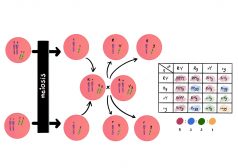Definition
The first of the two consecutive divisions of the nucleus of eukaryotic cell during meiosis, and composed of the following stages: prophase I, metaphase I, anaphase I, and telophase I
Supplement
Meiosis is a specialized form of cell division that ultimately gives rise to non-identical sex cells. There are two successive nuclear divisions: first meiotic division (or meiosis I) and second meiotic division (or meiosis II). Each of them has four major phases: prophase, metaphase, anaphase and telophase, and are also designated as I or II, depending on whether it occurs in meiosis I or meiosis II.
Briefly, meiosis I starts when the chromosomes condense along the center of the nucleus (prophase I), and pair with their homologues during crossing over (metaphase I). Next, the pairs of chromosomes separate and move to opposite ends of the cell (anaphase I). The cell divides for the first time producing two cells (telophase I). The two cells will undergo meiosis II wherein both of them divide further into two cells.
Meiosis I is essential since it allows the separation of homologous chromosomes. Each of these homologous chromosomes is still comprised of two sister chromatids, which will be separated at meiosis II, thereby reducing the chromosome number by half. It is also during meiosis I that genetic diversity and variability are promoted (particularly during prophase I).
Also called:
- first meiotic division
Compare:
See also:
- meiosis
- prophase I
- metaphase I
- anaphase I
- telophase I







